[Here’s a link to other forays around my map.]
Historical names for February include the Old English terms Solmonath (mud month) and Kale-monath (named for cabbage). In Finnish, the month is called ‘helmikuu’, meaning “month of the pearl”; when snow melts on tree branches, it forms droplets, and as these freeze again, they are like pearls of ice. In Macedonian the month is ‘sechko’, meaning month of cutting wood. In Slovene, February is traditionally called ‘svečan’, related to icicles or Candlemas. The name was also spelled sečan, meaning “the month of cutting down of trees”.
I was definitely in a mud month here, rather than a pearl month. The month of cutting down trees also felt relevant, however, for my first impression on entering today’s grid square was of swathes of cleared land, stripped and flattened ready to build a collection of apartments and homes. Hundreds of metres of footpath are closed off for the next four years and I was detoured along a road instead. Rather than tossing away their used crisp packet, someone had bizarrely tucked theirs beneath a fragment of discarded tombstone.

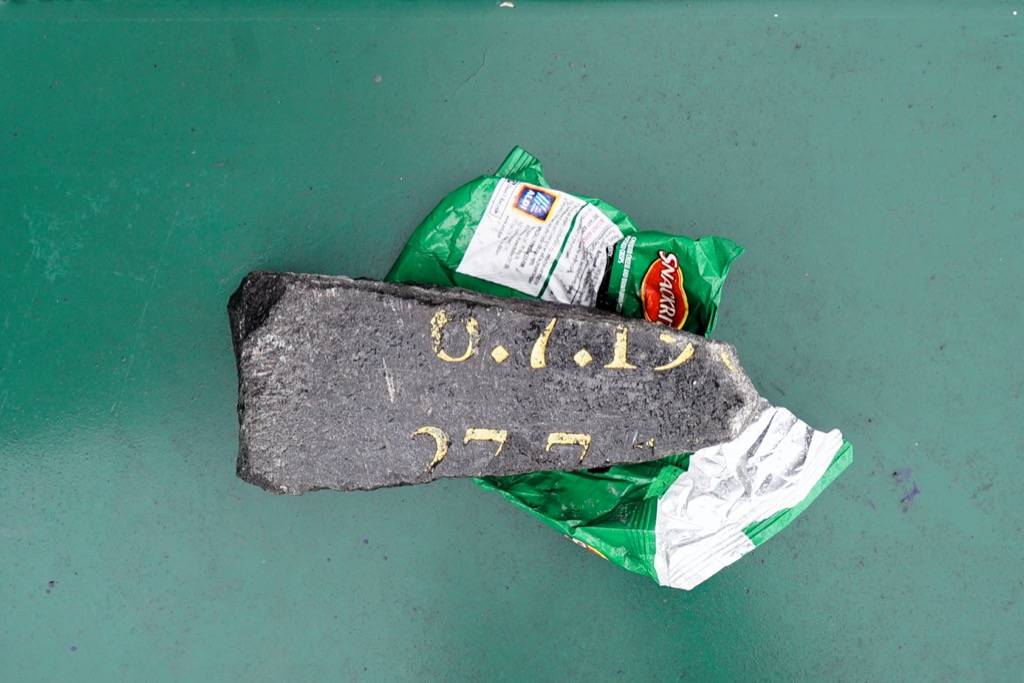
I know that the UK’s chronic housing shortage is one of the biggest challenges the country faces. The Government is aiming to build 300,000 new homes every year to match demand and keep housing costs affordable, but less than 250,000 were built last year, the highest rate in a decade. Yet land is also a finite resource, and the map I am exploring seems destined to disappear beneath industrial parks and homogenous cul de sacs. Please can someone cleverer than me solve this conundrum?!
The day was mild but moist and there seemed to be little left alive. A big orange digger was carving away all the soil around one of the few remaining tall, spindly trees. Scoop, spin, repeat. Scores of saplings had been planted along the verge, but they were so squashed together in their plastic protective tubes that few had any long term prospects. It was a quota-filling exercise (“we planted hundreds of replacement trees”) rather than any meaningful compensation of habitat.
The footpath along the river was fenced off too, closed due to construction work. For the first time I had the feeling that this project was stupid, pointless, and frustrating. I was annoyed to be stuck in the crowded southeast of England where nature and beauty is being crowded out. This was not the message I wanted to share or the conclusion I hoped to reach when I began exploring a single map in detail. My apologies!
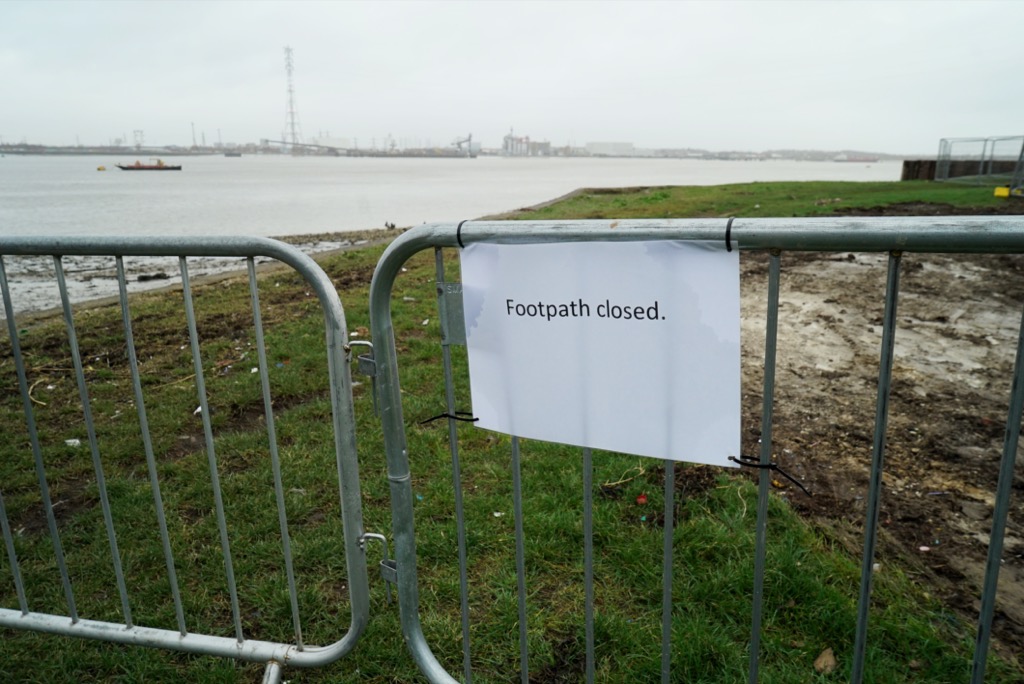
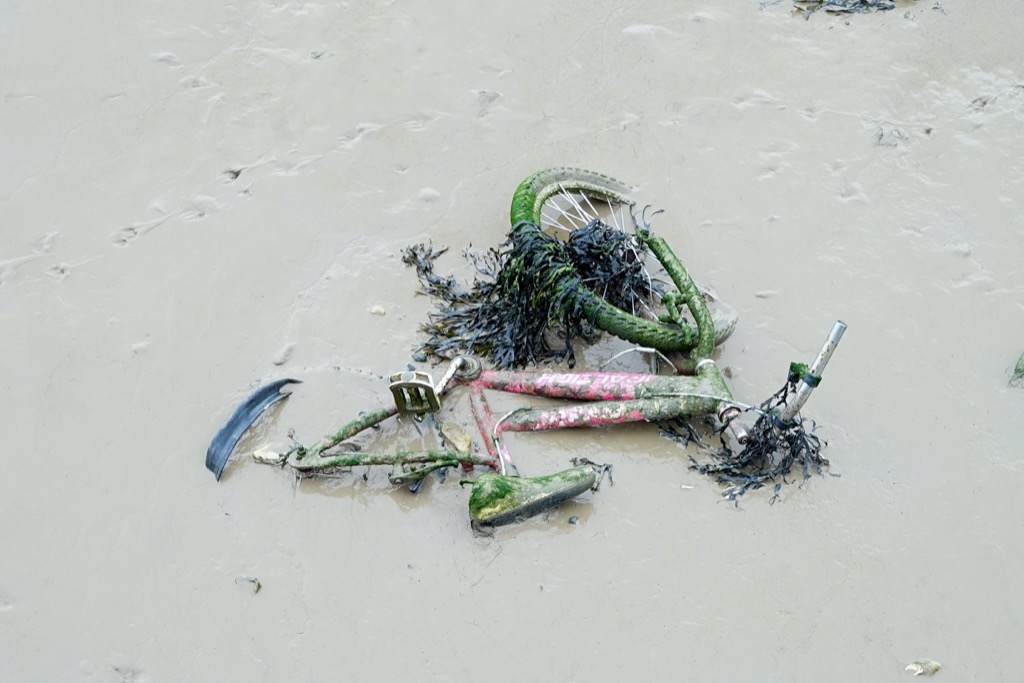
So I changed direction and climbed down onto a stony beach in front of a row of new-build apartments. I walked down to the water’s edge. The river is hundreds of metres wide here, silty, and swift. I would not dare to swim. The sky was the same colour (or lack of colour) – grey with a sulphurous hue. Pootling up and down the shore soon calmed me down and cheered me up: the gentle lapping of the water and the colours of the beach – dark flint nodules, smooth white lumps of chalk, broken old bricks, green slime, and shiny black seaweed. I indulged in a happy spot of mudlarking, finding a steering wheel and a football amongst the usual flotsam and jetsam of broken bottles, flip flops, traffic cones, and shopping trolleys. A child’s pink Raleigh bicycle lay forlornly in the mud.
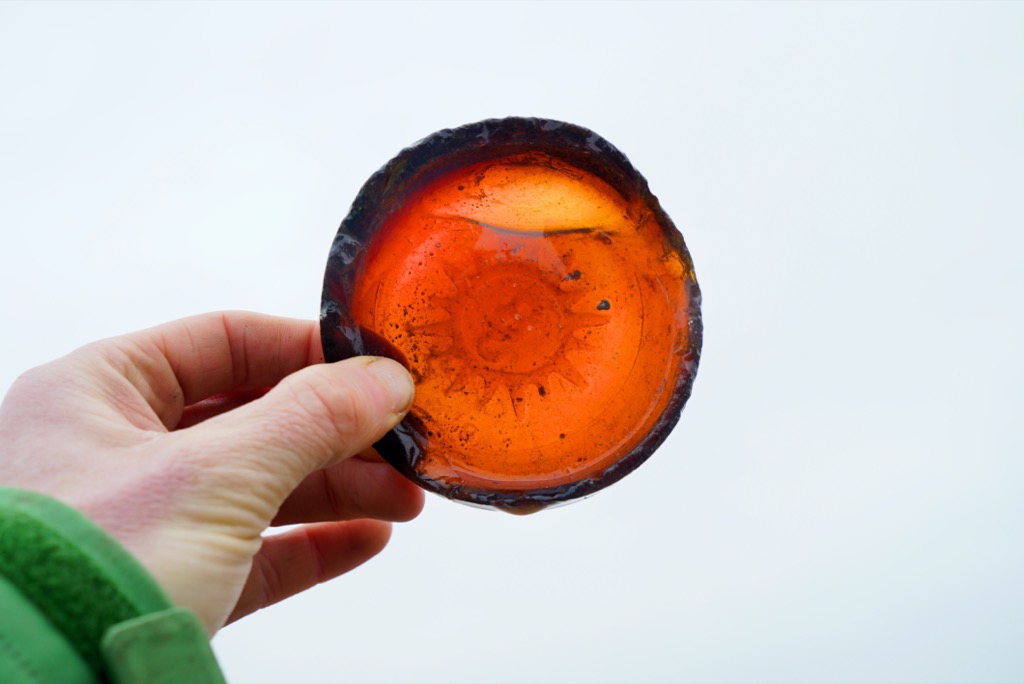
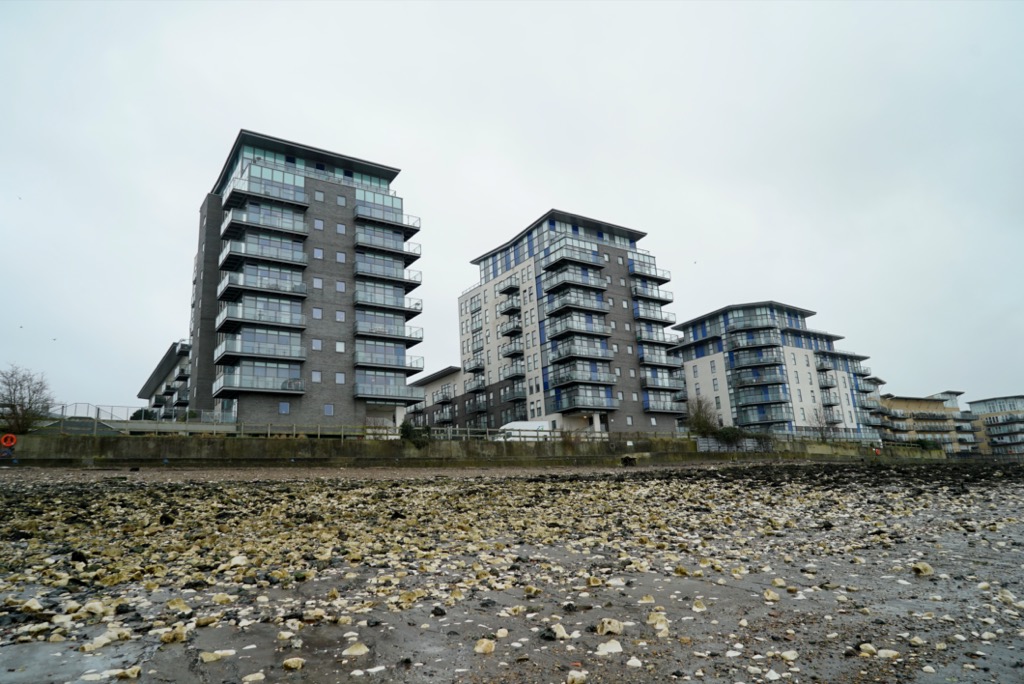

Hidden amongst the rubbish was a pulsing mass of sheltering sandhoppers. With their semi-translucent segmented bodies and oversized hind legs, they looked like composite creatures – part shrimp, part woodlouse, part flea. They can jump up to 30cm by rapidly flexing and releasing their abdomen and telson (a flap-like tail). Omnivorous scavengers, sandhoppers are nature’s refuse workers, helping to break down the vast quantities of dead and decaying material washed up on our shores. However, research revealed that these amphipods may actually be contributing to the spread of secondary microplastics within the marine environment. By monitoring them in the laboratory and on the shoreline, scientists discovered that they could shred a single plastic carrier bag into 1.75m microscopic fragments, with microplastics subsequently being found in their faecal matter.

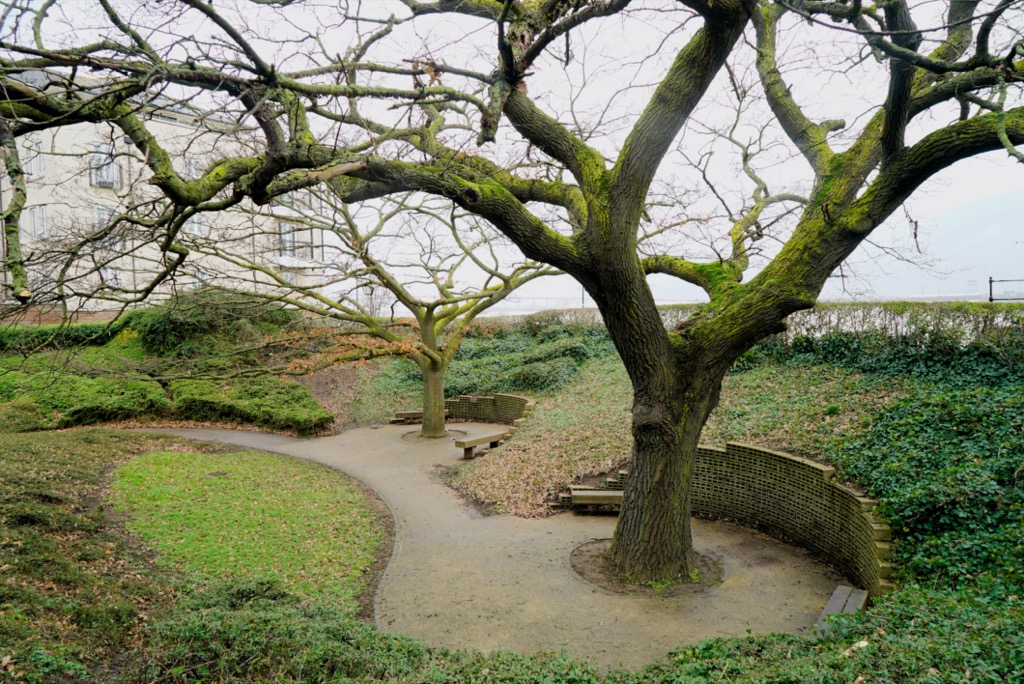
I continued cycling along the riverside walk and its bulky flood barriers. Someone had walked this way before the concrete had set, leaving a set of footprints like a ghostly reminder of their passing. Being so close to a city whose history has been linked to this river for thousands of years means that this grid square has continually piled new buildings onto old builds, history on history, always changing and evolving and beginning again. Ghosts and footprints, beginnings and endings and new beginnings again.
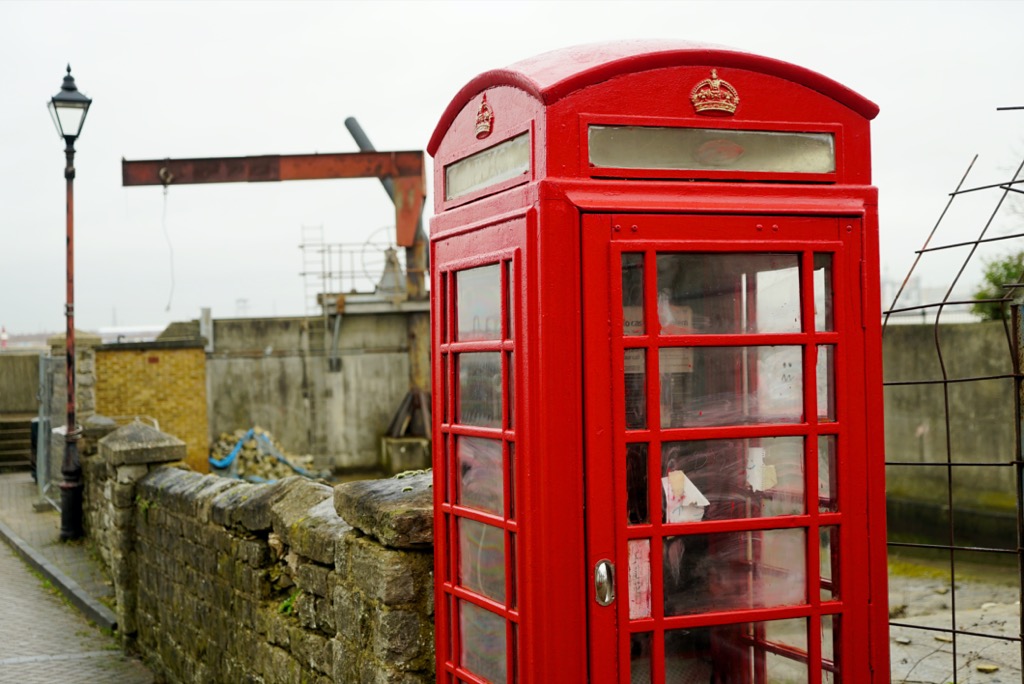
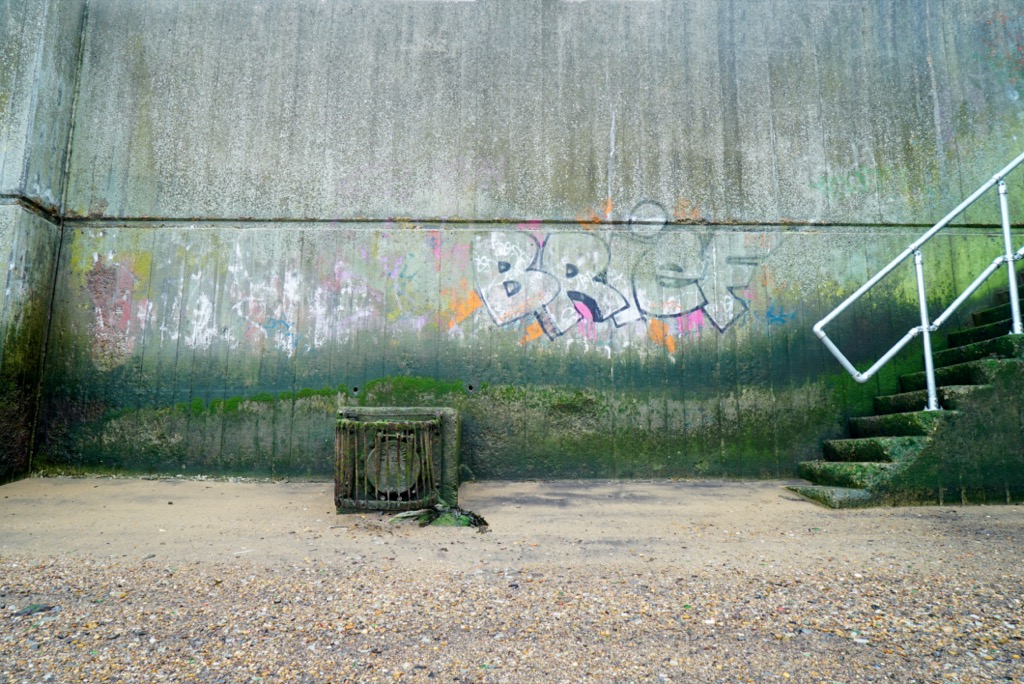
Take, for example, the grand old house perched on a grassy hill at the end of a boulevard that I was surprised to discover amongst all the modern developments. Its history spans from the 14th Century when the manor was home to nuns, it later became a country house for Henry VIII, and on eventually to today’s owner: an oil billionaire, his Cameroonian model wife and their eight kids, who together featured on ‘Britain’s Flashiest Families’! It is also, bizarrely, the Honorary Consulate of Lithuania.
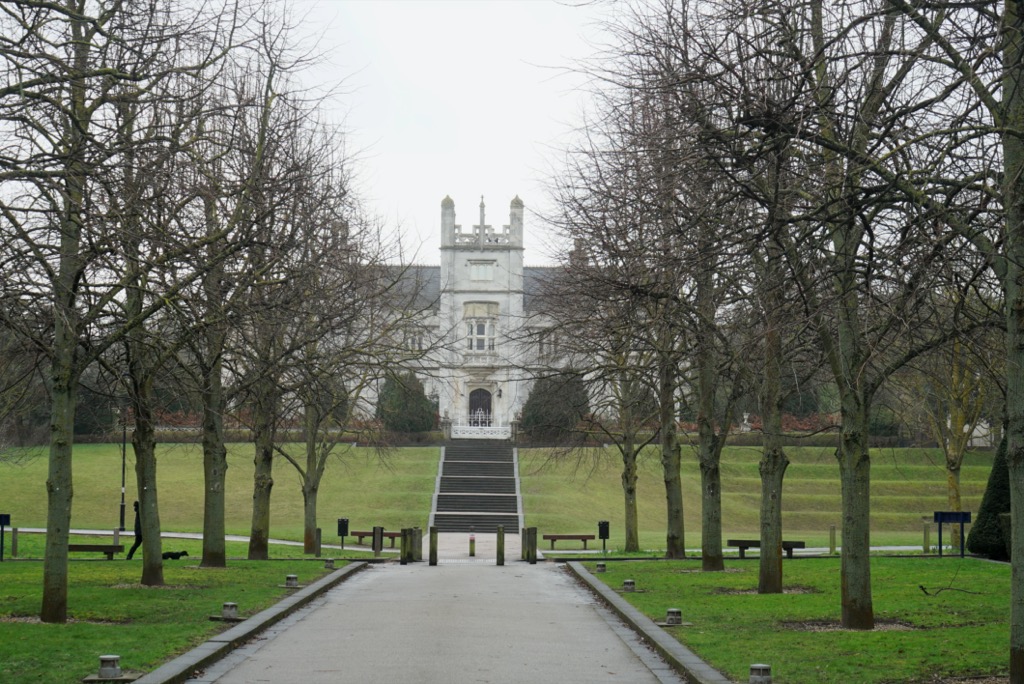
Somewhere amidst all that there was a nautical training college here, training cadets for a hundred years to serve as officers in the Merchant Navy. Cadets trained on the Cutty Sark here too, before she was moved to Greenwich as a national monument. Back in July 1883, Cutty Sark left Gravesend bound for Australia, arriving in October. After loading 4289 bales of wool and 12 casks of tallow, she departed in December 1883 and arrived back in London in March 1884. Her return passage of 83 days was the best of the year, beating every ship sailing at about the same time by 25 days.
In order to catch the Roaring Forties trade winds, Captain Woodget would travel further south than any previous commander. They encountered some of the most violent gales and seas on earth. The ship came into frequent contact with icebergs around Cape Horn. Fortunately, the ship survived and produced stunning passage times. On his first voyage in command, the ship sailed from England to Sydney in 77 days, and returned to the UK from Australia in 73 days. This was the start of ten years domination by Cutty Sark in the wool trade.
One famous trainee cadet at the college was Lieutenant Birdie Bowers, one of the four men who accompanied Captain Scott to the South Pole in 1912. Bowers was short, at five-foot four inches. He had red hair and a distinctive beak-like nose that quickly earned him the nickname of “Birdie” among his fellow explorers. He was known for his toughness, dependability, and cheerfulness. Apsley Cherry-Garrard, a fellow expedition member, remarked that his “capacity for work was prodigious”, and that “There was nothing subtle about him. He was transparently simple, straightforward, and unselfish”. In his diary, Scott wrote of Bowers that “he is the hardest traveller that ever undertook a Polar journey as well as one of the most undaunted”. In a letter to Bowers’ mother retrieved from the tent containing their bodies, Scott wrote “I write when we are very near the end of our journey, and I am finishing it in company with two gallant, noble gentlemen. One of these is your son. He had come to be one of my closest and soundest friends, and I appreciate his wonderful upright nature, his ability and energy. As the troubles have thickened his dauntless spirit ever shone brighter and he has remained cheerful, hopeful, and indomitable to the end.”
On such a built-up grid square I had not thought to look closely for the symbol for ‘cliffs’, but there they were: sheer white chalk cliffs in a small wooded park behind the Abbey. Follies were dotted around, their entrances locked with metal grilles to provide safe homes for the local pipistrelle bats. The common pipistrelle is so small, it can fit into a matchbox! Despite its size, it can easily eat 3,000 insects a night.
A woodpecker rattled in a tree somewhere nearby, Mistle thrushes sang with the enthusiasm of spring approaching, and pigeons coo-ed up on the cliff faces. I had thought this grid square was going to be a duffer, but there was so much here that I never knew existed!
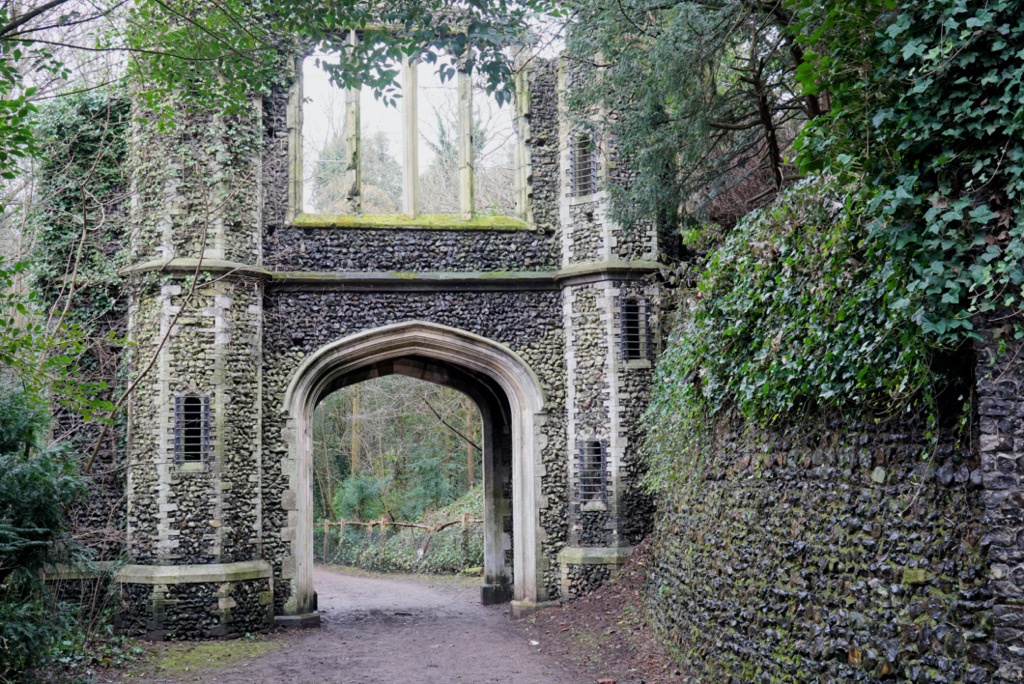

Feeling cheerful, I pedalled away from the new housing estate and into a wasteland of industrial units, decades-old with plastic flapping on barbed wire fences, and so much litter – Stella cans mostly, it seemed. It’s the sort of no-man’s land where you don’t hang around or take photos of scaffolding businesses run out of portakabins with black Range Rovers parked outside.
As for me, I was on my way to have a look at a pylon. What on earth has become of me?! And how I pity you, dear reader, if you are still persevering with my witterings. But this was no ordinary pylon.
The pylon was vast and dominated the sky from wherever I was in my grid square. I rode through a strange emptiness to reach it, with scrubby thickets, muddy footpaths, crumbled tracks with Keep Out notices, silver birch saplings, graffiti tags, and the glimmer of broken glass. In fact, truth be told, the pylon lay out of today’s square, but it lured me to have a look anyway. The 190-metre-high pylon is the tallest in the UK, enabling a 400kV electricity cable to stretch 1300 metres across the river. Its base was fortified with CCTV, spiked railings, and electric fences. Its stark, simple symmetry soared above me, beautiful in its own way.
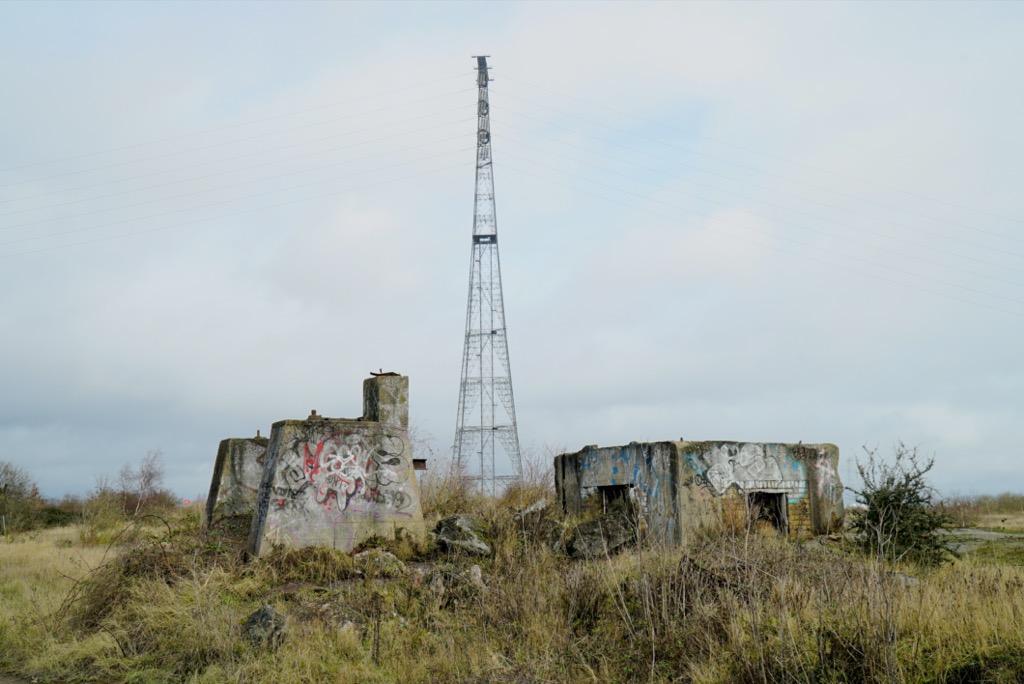

I had intended to turn around at the pylon, but over the undergrowth I spotted the tall mast of a wooden boat. Intrigued, I pressed on and stumbled upon what I imagine will become one of my favourite hidey-holes of my entire map.
Tucked away from the surging flow of the main river was a creek, folded tightly into the shore like a shirt cuff. It was low tide so the creek was just a muddy river bed lined with reeds. Just that, plus a fantastic, ramshackle assortment of boats. ‘Marina’ is far too grand a term for the collection of dilapidated wooden walkways, driftwood cabins, and craft in various states of disrepair. And, in my opinion, it was far more alluring than a shiny Marina. Peeling wooden hulls, scuttled fishing boats, wobbly homemade jetties and huts: it felt like the marshlands of North Carolina, the bayous of Lousiana, or a fishing village in Haiti. There was an old keg of beer, an old speedboat turned into a flowerbed, and a hand-sprayed sign warning ‘Beware of Dog!’
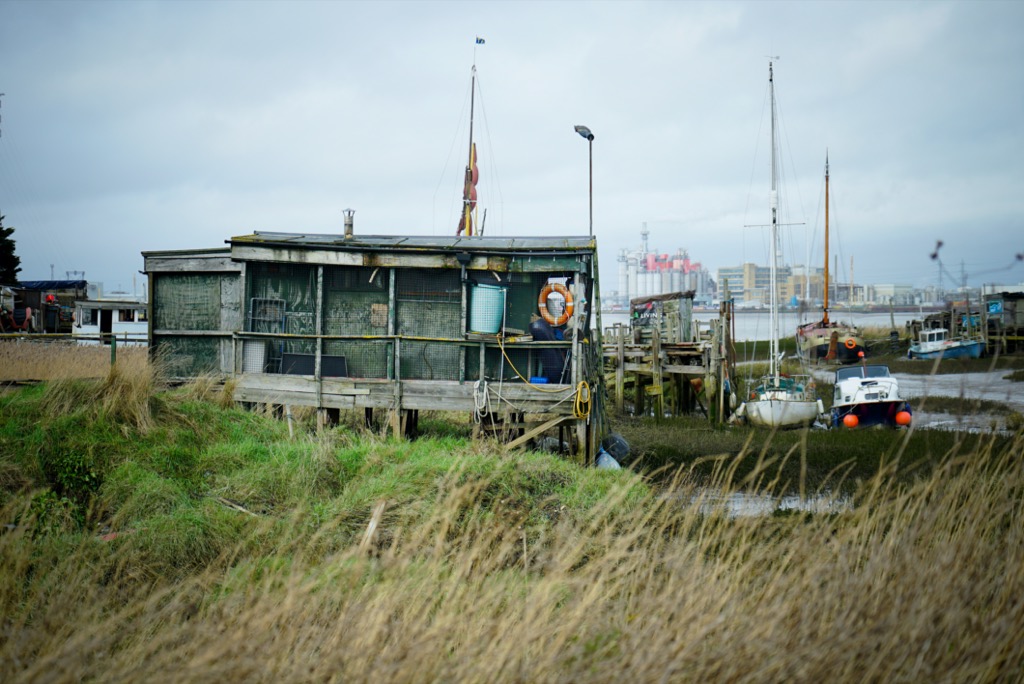
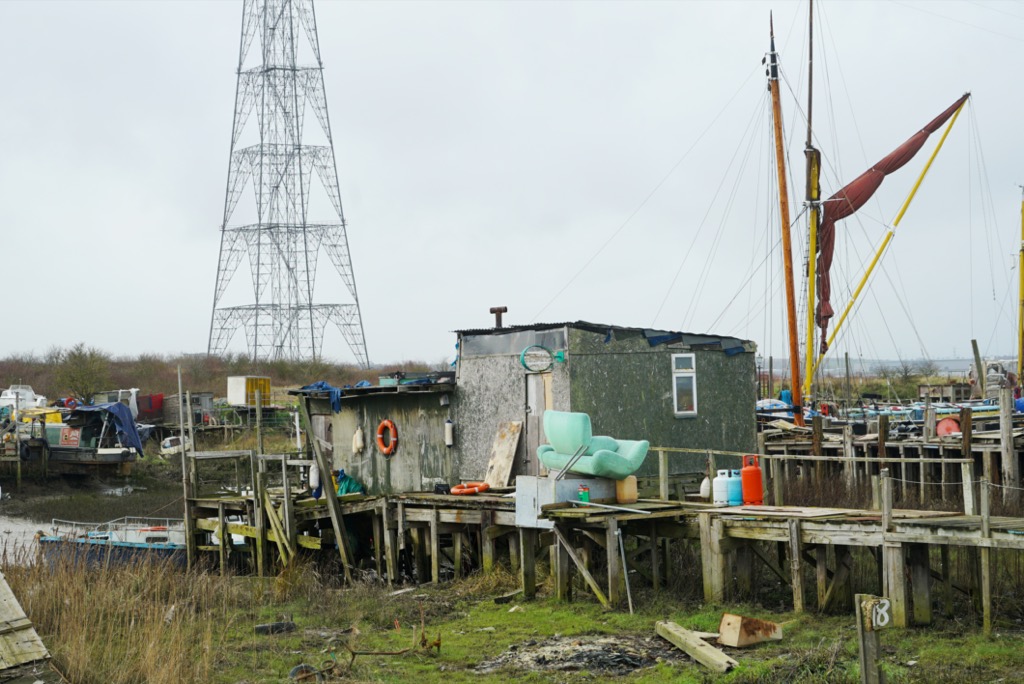
Amongst the crumbling craft, some abandoned, others in varying degrees of no doubt eternal ‘repairs’, were two beautiful old Thames Barges (see previous grid square about barges). Built in 1926 by Short Brothers at Rochester for Bradleys of Rochester, Lady Jean is a Thames Sailing Barge of wooden carvel construction. She made history on her first commercial voyage which was to Coruna in Northern Spain; this is believed to be the longest cargo carrying trip ever made by a Thames Sailing Barge. Subsequently she traded from the Medway to ports in Cornwall carrying cement and returning with cargoes of china clay or granite. Painted black, with yellow masts, this was the boat I had spotted from the pylon. Older still was the Dutch boat Femmigje, built in 1907 in Groningen.
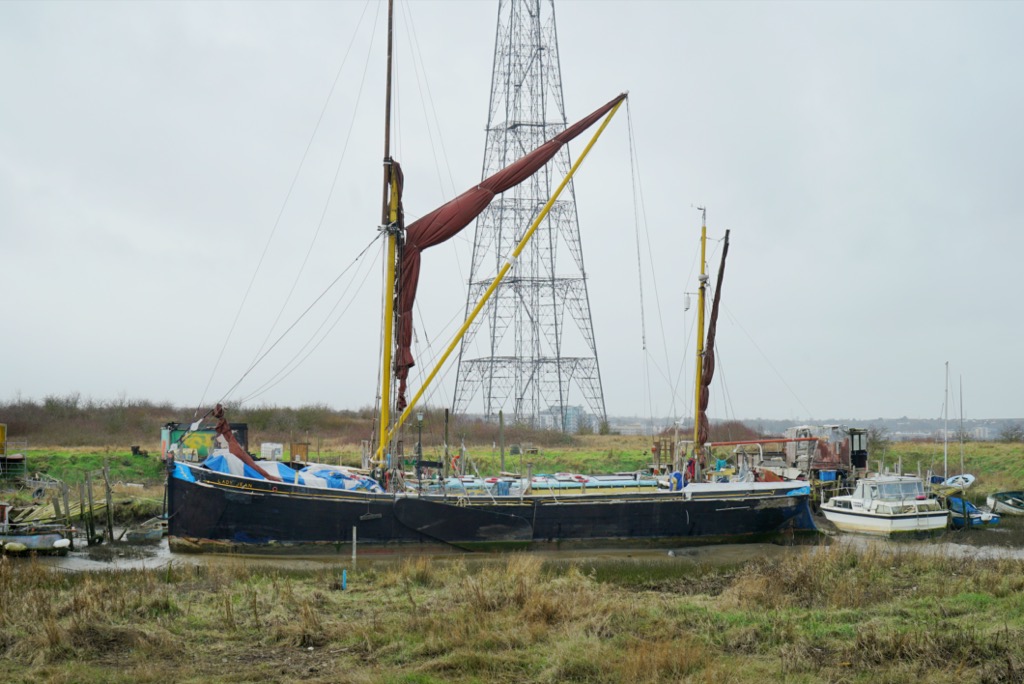
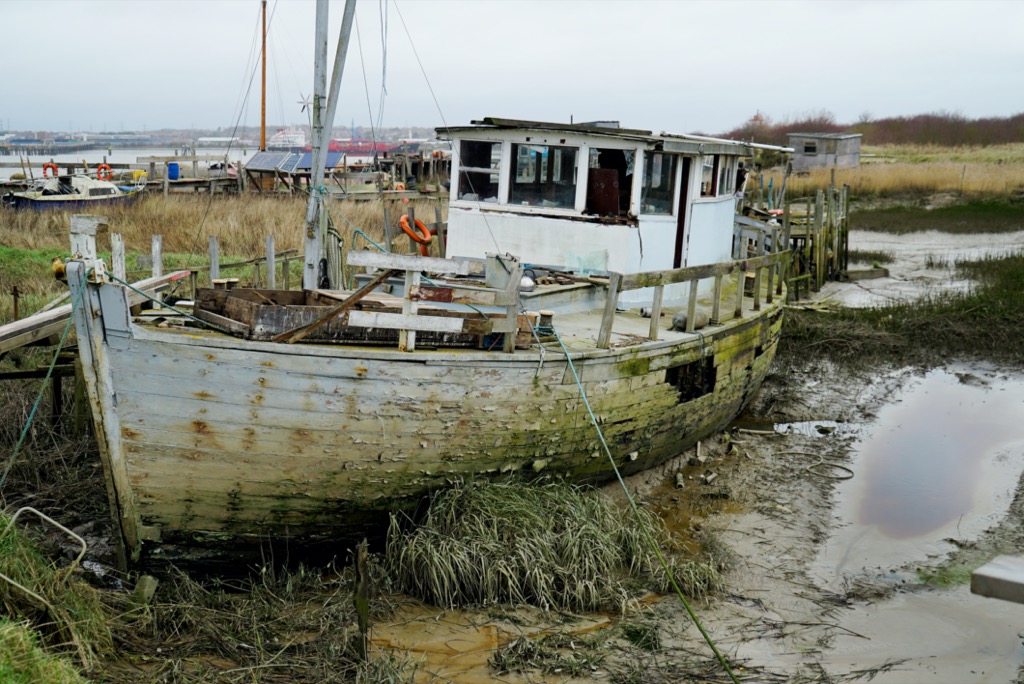
The only sound came from a small man with a wizardy face, a beard, and a flat cap. He was whacking a rusted trailer wheel with great determination, his hammer-wielding watched patiently by his young grandson (I guessed). I went over for a chat, wanting to share my delight at this quirky spot. He told me that he was renovating a small motorboat so that they could go fishing out in the river. “We go right out, far out. There’s cod there. Whiting. Flatties, too – flounders and that.”
As people tend to do when you express an interest in a place, he began to share what he knew with me, speaking fondly about the owls that lived out on this scrappy marsh (Barn and Tawny), the kestrels, and the nightingales that churred their famous song at dawn and dusk in the summertime. All this is the scene of the unlikeliest of planning battles: a fight between the (magnificently named) ‘Distinguished jumping spider’ and a rollercoaster judged to be “nationally significant infrastructure”.
Ambitious £3.5bn plans for the biggest theme park in Britain beside the Thames threaten what conservationists say is the best site in the country for rare invertebrates. This peninsula is earmarked for a theme park with rides inspired by shows from BBC Studios, ITV Studios and Paramount Pictures, alongside hotels, restaurants and a conference centre.
But the site, a mix of local nature reserves, marshes, pasture and a former concrete works, is currently home to 1,992 species of invertebrates including 250 of conservation concern. (There’s a petition against the theme park here.)
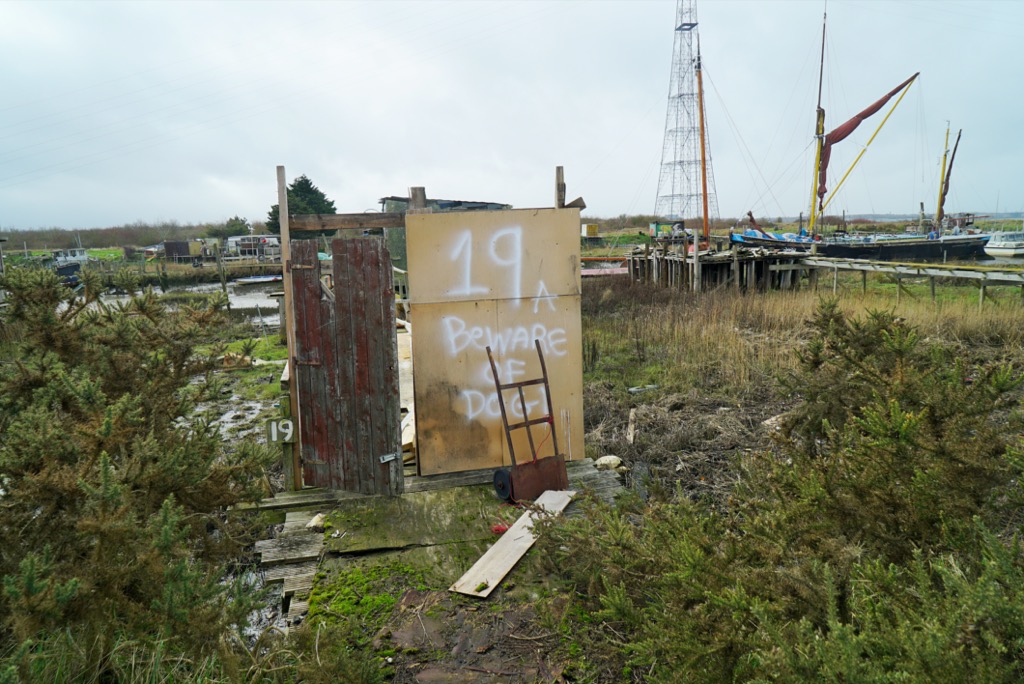
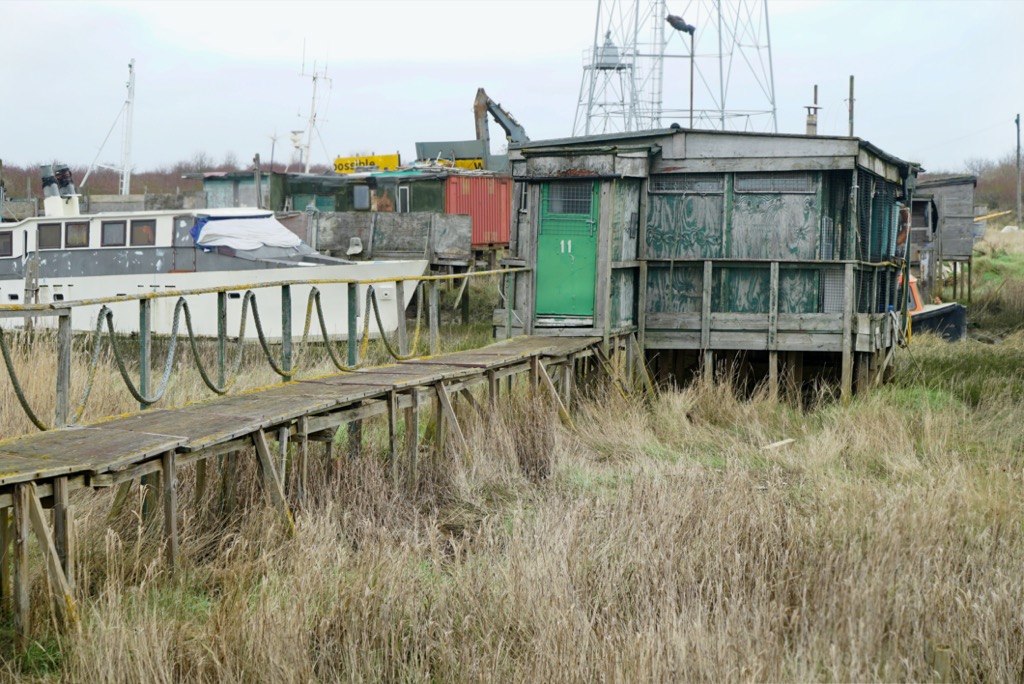
I said goodbye and walked down to the riverbank to find a spot to make coffee and take all this in. Yes, there were shopping trolleys in the mud and shocking amounts of plastic rubbish. But I was in high spirits as I sheltered behind a large concrete block sprayed with ‘AHOY’ and a smiley face.
At the beginning of today’s explorations I had been pessimistic and questioning what I was doing. Yet once again I had found so much fascination, history, and beauty. Yes, I’m not done yet with this project.


Usually I take a thermos flask of coffee with me. But today I had brought my tiny stove to do the job properly. Taking the time to heat the water and allow the coffee to brew (using compostable coffee bags from the Fell Store / @the_fell_store) gives you time to settle and think. It was a mild, early spring day and I sipped contentedly from the mug I was gifted by Ben Cummins, a man on a mission to deliver a piano from Liverpool to London. On a home-made raft. That he propels himself. Within 25 years… So far it has taken Ben seven years to push his raft the 127 miles along the canal from Liverpool to Leeds!
This adventure / art project / way of life began when Ben asked himself a brilliant question, “what is it that I want from my life?”
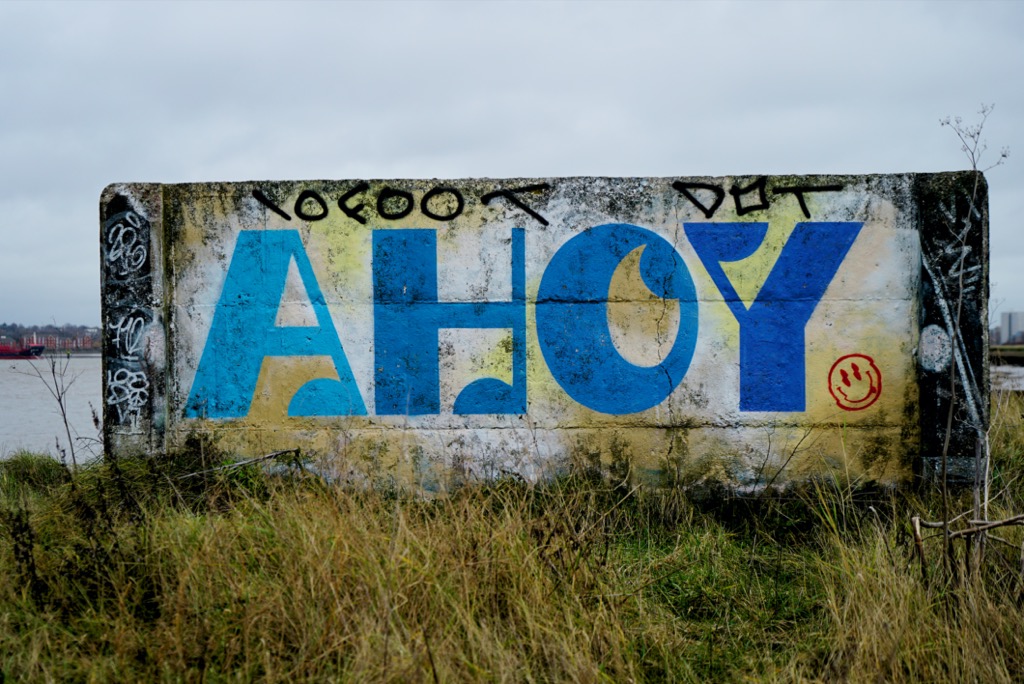

I was inspired to do this by a small collaboration I have begun with artist Anna Brones. Our first venture was to urge people to enjoy coffee outside:
Momentous and wondrous things — adventure, a piece of art, a new project — begin with a seed of an idea, a cup of coffee, and then the decision to begin.
Whether it is ‘putting the kettle on’ in Britain when hatching plans, Sweden’s daily fika to savour life’s small joys, or ‘grabbing a coffee’ in North America to toss around exciting ideas, we believe that good stuff comes from coffee.
We appreciate the familiarity of a favourite mug, the performance of the preparation or the ritual of going to a favourite cafe. We take pleasure in the caesura, the space created by pausing for coffee, and perhaps a faint glimpse of the Buddhist notion that you can experience the universe by drinking a bowl of tea.
So coffee is where we are going to begin this new journey towards exploring the link between adventure, creativity, curiosity, and wellbeing. [By the way ‘tea’ can be used interchangeably with ‘coffee’ throughout. Perhaps not ‘Beer’ though, if you’re reading this early in the day!]
What if we try something different with our daily ritual? Nothing dramatic, nothing to worry about or procrastinate. Just a tiny step towards something different. Sometimes that can be all you need to leave your rut. Nudge the helm, trim the sail of a small boat leaving Java and you’ll shift your landfall from Kenya to Yemen.
Today we nudge you to take your coffee outside and experience an extra sliver of the universe. A cup of coffee in the fresh air cracks open the space to allow ideas to percolate and brew. For adventure ideas. For a blackbird waiting for this moment to arise. For creative impulses and a breath of breeze. The time to observe, notice and appreciate the world outside your front door.
As we begin this journey together we have to respectfully disagree with Bilbo Baggins. He advised Frodo that going out your door was a dangerous business, for there’s no knowing where you might be swept off to. But we see the possibility of surprise and serendipity out there as marvellous things, invitations to exploration and to everyday, simple activities that fill life with joy and inspiration.
The hardest part of any adventure is what Norwegians call the ‘dørstokkmila‘, the doorstep mile, cajoling yourself to leave the comfortable, familiar house, step out of a rut and into the world. The doorstep mile is the longest mile of any journey.
Before Russians begin a journey they sit down together and pause in silence to clear their heads and bring good fortune. The tradition is called ‘sidet na chemodanakh’ or ‘sitting on your suitcases’. Our bags are not yet packed, but we have now begun to dream.
Abraham Lincoln supposedly said that if he had six hours to chop down a tree, he would spend the first four hours sharpening the axe. Similarly, when we plan an adventure, a book, or a new work of art, we first of all pause for coffee.
Who are you? Where are you? How will you take your coffee today? We want to hear from you, and where these outdoor moments take place. Perhaps you’ll sit amongst the pigeons on a park bench with your latte. Or with an espresso and a croissant at a terracotta-tiled cafe beside the emerald waters of the Adriatic. You may walk outside in the middle of winter barefoot, standing on your porch in bare feet, feeling the cold of the season, the hot mug in your hands. You could fill a thermos and set out on foot for the woods. Or you might prefer to brew your coffee outside. A gas stove and a sprinkle of instant. A jetboil and French press. Aeropress. Bialetti. Briki. A kelly kettle or a coffee bag. Java drip, filter, press pot or percolator. A Moka pot and wanderlust for al-Makha. Perhaps you’ll gather twigs and light a fire for cowboy coffee or forage, roast and grind a beech nut substitute coffee. Or maybe you’ll simply carry your cup from kitchen to sunlit garden and sit for a while, caging the minute within its nets of gold.
We are fascinated by the concept of adventure, something that often comes with a sense of uncertainty and unknown. This past year has presented us with ample amounts of uncertainty in our everyday, and our thoughts about –and approach to– ‘adventure’ has most certainly shifted. Our journeys now are closer to home. We are challenged to stay curious and find joy in our most trivial moments. It’s easy for things to become routine and mundane. This is why we should use something as small as a change in daily ritual to bring us a hint of what we have missed. It holds the possibility of surprise and serendipity, and offers an invitation to exploration and the simple activities that fill life with joy and inspiration.
Whilst we doubtlessly want adventure, we also crave ways to slow down and be present, to connect with the world around us, and generate the opportunity to pursue our creativity. Mark this cup of coffee as the beginning of that quest. To consciously look askew at the way we do things. An interlude to pay attention and be grateful. And a chance, with the final sip, to acknowledge how easy that was and to commit to try something similar again.
This might merely be drinking a cup of coffee outside. But it may also be the birth of a new adventure. We do not yet know. But we have begun to find out.
[A collaboration with Anna Brones – the masterful papercut artist.]
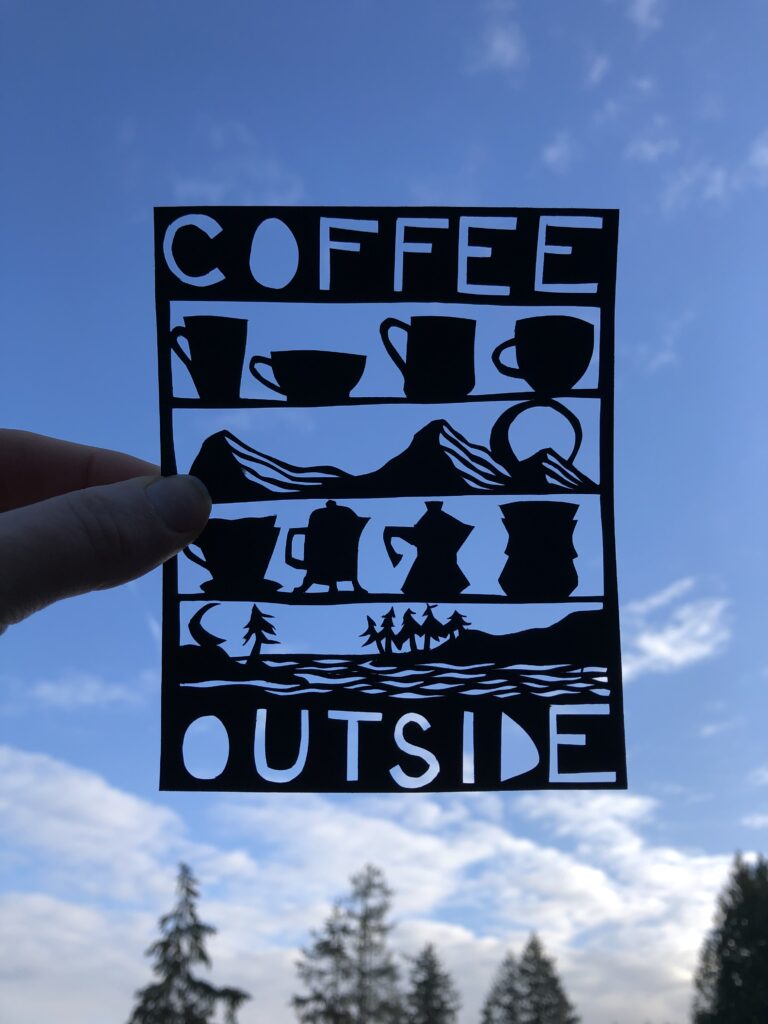



This report addresses your concern over land and housing. I think it was published last week:https://assets.publishing.service.gov.uk/government/uploads/system/uploads/attachment_data/file/861832/Living_with_beauty_BBBBC_report.pdf
Thank you Alastair… you’re my inspiration. I had started ( resuming) drawing/ painting and then just lost momentum mainly cause I’m so bad at it. I have decided to set time aside daily so I suck a little less. I love on Manitoulin Island in Ontario which is a beautiful pet of the world and I’m grateful. My outside wandering are going to be a little more often than they currently are and my inside jobs will just have to take a bit of a back seat …. life is short. Enjoy your newsletter – thanks
Thanks for sharing, your fun, interesting observations.
The trash though, is horrific.
Earth Day is coming! I wonder if you could encourage some cleanup activities? Perhaps send the photos to the local news and port authorities? Or maybe you have a Sunrise Movement or other young climate activists?
Hi Alastair,
thanks for writing theses single map posts! Your view on the world cheers me up, especially on mornings like these when not everything is fine (here, and expectedly not for too long, I hope). Your writings and pictures express an honest experience, also makes me want to go out again in rainy weather:-) All the best!
Thank you Sabrina!